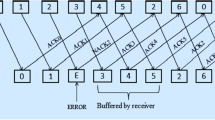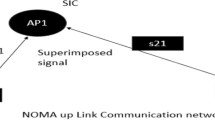Abstract
This paper discusses an extended modulation mapping technique to improve hybrid automatic repeat request (ARQ) protocols by reducing communication errors in wireless systems. The extended mapping (EM) hybrid ARQ (HARQ) protocol has been developed using irregular repetition code with turbo processing. This protocol uses EM and ARQ to improve efficiency, including retransmission for error correction. The existing hybrid ARQ technique uses a horizontal iterative decoding scheme to reduce error. The suggested method employs both serial and parallel iterative decoding schemes for error detection and correction. A bit error rate (BER) analysis evaluates the proposed model, EM-HARQ performance in the additive white Gaussian noise channel. The results show a significant gain in signal-to-noise ratio (SNR) from the theoretical limit of the irregular repetition coding using MATLAB simulation software. The adoption of EM in the proposed method improves the SNR to a 0.99 dB performance gap difference and 0.3 dB performance gain due to enhanced error detection. Even with low SNR channels, the proposed EM-HARQ system can achieve a low BER and close to the theoretical limit capacity.












Similar content being viewed by others
Data availability
Enquiries about data availability should be directed to the authors.
References
Ahmad Z, Ahmad I, Love DJ, Smida B (2018) Analysis of two-unicast network-coded hybrid-ARQ with unreliable feedback. In: IEEE transactions on vehicular technology
Anwar K, Matsumoto T (2010). MIMO spatial turbo coding with iterative equalization. In: 2010 international ITG workshop on smart antennas (WSA), pp 428–433. IEEE
Anwar K, Matsumoto T (2012) Very simple BICM-ID using repetition code and extended mapping with doped accumulator. Wirel Pers Commun 67(3):573–584
Barrueco J, Montalban J, Iradier E, Angueira P (2021) Constellation design for future communication systems: a comprehensive survey. IEEE Access 9:89778–89797. https://doi.org/10.1109/ACCESS.2021.3090774
Berggren F, Jianghua Liu (2012) Channel selection HARQ feedback in LTEAdvanced. Vehicular technology conference (VTC spring), 2012 IEEE 75th
Brannstrom F, Rasmussen LK, Grant AJ (2005) Convergence analysis and optimal scheduling for multiple concatenated codes. Inform Theory, IEEE Trans 51(9):3354–3364
Braun V, Doetsch U, Zimaliev A, Bonomo M, Vangelista L (2014) Performance of asymmetric QPSK modulation for multi-level ACK/NACK in LTE uplink. In: European wireless 2014; 20th European wireless conference, pp 1–6. VDE
Chauvat R, Garcia-Pena A, Paonni M (2021) Design of iterative demapping schedules for reduced-complexity BICM-ID with binary ldpc codes and orthogonal modulations. In: 2021 11th international symposium on topics in coding (ISTC). pp 1–5. https://doi.org/10.1109/ISTC49272.2021.9594275
Das, Barnali & Sarma, Manash & Sarma, Kandarpa & Mastorakis, Nikos (2015) Design of a few interleaver techniques used with gold codes in faded wireless channels. https://doi.org/10.1109/SPIN.2015.7095292
Farzamnia A, Hlaing NW, Mariappan M, Haldar MK (2018a) BER comparison of OFDM with M-QAM modulation scheme of AWGN and rayleigh fading channels. In: 2018a 9th IEEE control and system graduate research colloquium (ICSGRC), pp 54–58
Farzamnia A, Hlaing NW, Mariappan M, Fan LC (2018b) Network coding schemes with MIMO-NOMA for two-way relay networks. In: 2018b IEEE international conference on artificial intelligence in engineering and technology (IICAIET), pp 1–5. IEEE
Fu B, Xiao Y, Deng H, Zeng H (2013) A survey of cross-layer designs in wireless networks. IEEE Commun Surv Tutor 16(1):110–126
Fukawa K, Ormsub S, Tölli A, Anwar K, Matsumoto T (2012a) EXIT-constrained BICM-ID design using extended mapping. EURASIP J Wirel Commun Netw 1:1–17
Fukawa K, Ormsub S, Tölli A, Anwar K, Matsumoto T (2012b) EXIT-BICM-ID design using extended mapping. EURASIP J Wirel Commun Netw 2012(1):40
Fukawa K, Zhao D, Tolli A, Matsumoto T (2010) Irregular repetition and single parity check coded BICM-ID using extended mapping-optimal node degree allocation. In: 2010, IEEE 5th international ICST conference on communications and networking in China, pp 1–6
Henkel P (2006) Extended mappings for bit-interleaved coded modulation. In: 2006 IEEE 17th international symposium on personal, indoor and mobile radio communications, pp 1–4, IEEE
Henkel P (2007) Doping of extended mappings for signal shaping. In: 2007 IEEE 65th vehicular technology conference-VTC2007-Spring, pp 1851–1855. IEEE
Henkel P (2007) Extended mappings for bit-interleaved coded modulation. Personal, indoor and mobile radios communications, Helsinki, Finland, pp 1–4
Hlaing NW, Farzamnia A, Mariappan M, Haldar MK (2019) Network coding schemes with efficient LDPC coded MIMO–NOMA in two-way relay networks. IET Commun 14(2):337–348
Ade Irawan (2013) Turbo hybrid automatic repeat request (HARQ), Master of Science, Japan advanced institute of science and technology, Japan
Irawan A, Anwar K, Matsumoto T (2013) Combining-after-decoding turbo hybrid ARQ by utilizing doped-accumulator. Commun Lett, IEEE 17(6):1212–1215
Jagath-Kumara KDR (2015) Implementation problems of retransmission protocols: SR-ARQ revisited. AEU-Int J Electron Commun 69(2):596–603
Kaidi HM, et al. (2017) Performance of simple turbo process with non-standard mapping. TENCON 2017—2017 IEEE region 10 conference, Penang, Malaysia, pp 2297–2300. https://doi.org/10.1109/TENCON.2017.8228244
Kao C, Juang R, Hsu J, Ting P (2009) Enhanced HARQ using prioritized bit selection and rearrangement for WiMAX systems. In: 2009 IEEE mobile WiMAX symposium, Napa Valley, CA, pp 16–19
Koike T, Murata H, Yoshida S (2004) Hybrid ARQ scheme suitable for coded MIMO transmission. In: Proc IEEE Int Conf Commun (ICC), Paris, France
Lv T, Xia J, Long F (2011) DSC and universal bit-level combining for HARQ systems. EURASIP J Wirel Commun Netw 2011(66):1–12
Mad Kaidi H, Ahmad N, Mohd Izhar MA, Mohd Sam S, Fisal N (2016) Irregular repetition code hybrid ARQ in wireless system. J Teknol 78(6–2):1–6
Marcille S, Ciblat P, Le Martret CJ (2012) Stop-and-wait hybrid-ARQ performance at IP level under imperfect feedback. Vehicular technology conference (VTC Fall), 2012 IEEE
Bin Pang et.al (2008) Hybrid ARQ technique employing a signal constellation rearrangement based on 256-QAM. In: Proceedings of the 2008 international conference on advanced infocomm technology (ICAIT '08). ACM, New York, NY
Park J, Ji DJ, Cho D-H (2021) High-order modulation based on deep neural network for physical-layer network coding. IEEE Wirel Commun Lett 10(6):1173–1177. https://doi.org/10.1109/LWC.2021.3060750
Pfletschinger S, Sanzi F (2006) Error floor removal for bit-interleaved coded modulation with iterative detection. IEEE Trans Wirel Commun 5(11):3174–3181
Schädler M, Böcherer G, Pachnicke S (2021) Soft-demapping for short reach optical communication: a comparison of deep neural networks and volterra series. J Lightwave Technol 39(10):3095–3105. https://doi.org/10.1109/JLT.2021.3056869
Siregar RF, Murti FW, Shin SY (2019) Bit allocation approach of spatial modulation for multi-user scenario. J Netw Comput Appl 127:1–8
Souza RD, Uchôa AGD, Pellenz ME (2010) A novel hybrid ARQ scheme using turbo codes and diversity combining. AEU-Int J Electron Commun 64(11):1078–1081
Szczecinski L, Ceron A, Feick R (2009a) Mapping rearrangement for HARQ based on low-order modulation. IEEE Trans Commun 57(5):1351–1358
Szczecinski L, Ceron A, Feick R (2009b) Mapping rearrangement for HARQ based on low-order modulation. Commun, IEEE Trans 57(5):1351–1358
Szczecinski L, Diop F-K, Benjillali M, Ceron A, Feick R (2007) BICM in HARQ with mapping rearrangement: capacity and performance of practical schemes, ‖ IEEE GLOBECOM"07, Washington DC, USA
Szczecinski L, Ceron A, Feick R (2008) Mapping Rearrangement for HARQ Based on BPSK. In: Global telecommunications conference, 2008. IEEE GLOBECOM 2008. IEEE, pp 1–6
Ten Brink S (1999) Convergence of iterative decoding. Electron Lett 35(13):1117–1119
Ten Brink S (2001) Convergence behavior of iteratively decoded parallel concatenated codes. IEEE Trans Commun 49(10):1727–1737
War Hlaing N, Farzamnia A, Mariappan M, Kumar Haldar M (2020) Network-coded MIMO-NOMA systems with FEC codes in two-way relay networks. Int J Commun Syst 33(11):e4419
Zhan M, Pang Z, Xiao M, Luvisotto M, Dzung D (2018) Wireless high-performance communications: improving effectiveness and creating ultrahigh reliability with channel coding. IEEE Ind Electron Mag 12(3):32–37
Dan Zhao (2010) Irregular repetition code-based bit interleaved coded modulation with iterative decoding (BICM-ID) using extended mapping in broadband wireless communication with turbo equalization, Master of science thesis, Japan Advanced institute of science and technology, Japan
Zhao D, Dauch A, Matsumoto T (2009a) BICM-ID using extended mapping and repetition code with irregular node degree allocation. In: VTC Spring 2009a-IEEE 69th vehicular technology conference, pp 1–5. IEEE
Zhao D, Dauch A, Matsumoto T (2009b). Modulation doping for repetition coded BICM-ID with irregular degree allocation. EURASIP
Zhu J, Liu W, Pan Z, Lei J, Li W (2019) Design of mapping matrix for arithmetic bit-interleaved coded modulation. IEEE Access 7:55898–55905. https://doi.org/10.1109/ACCESS.2019.2910935
Funding
This research was supported by the Ministry of Higher Education (MoHE) of Malaysia through the Fundamental Research Grant Scheme (FRGS/1/2021/TK0/UTM/02/67).
Author information
Authors and Affiliations
Corresponding author
Ethics declarations
Conflict of interest
The authors have not disclosed any competing interests.
Additional information
Publisher's Note
Springer Nature remains neutral with regard to jurisdictional claims in published maps and institutional affiliations.
Rights and permissions
Springer Nature or its licensor (e.g. a society or other partner) holds exclusive rights to this article under a publishing agreement with the author(s) or other rightsholder(s); author self-archiving of the accepted manuscript version of this article is solely governed by the terms of such publishing agreement and applicable law.
About this article
Cite this article
Mad Kaidi, H., Ahmad, N., Mohd Izhar, M.A. et al. Extended modulation mappings for hybrid ARQ in wireless communication systems. Soft Comput 28, 2469–2481 (2024). https://doi.org/10.1007/s00500-023-08492-3
Accepted:
Published:
Issue Date:
DOI: https://doi.org/10.1007/s00500-023-08492-3




